11 Developmental Milestones
Two Months
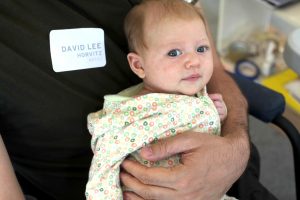
Cognitive
- Pays attention to faces
- Begins to follow things with eyes and recognize people at a distance
- Begins to act bored (cries, fussy) if activity doesn’t change
Fine Motor
- Grasps reflexively
- Does not reach for objects
- Holds hands in fist
Gross Motor
- Can hold head up and begins to push up when lying on tummy
- Makes smoother movements with arms and legs
Language
- Coos, makes gurgling sounds
- Turns head toward sounds
Social and Emotional
- Begins to smile at people
- Can briefly calm himself (may bring hands to mouth and suck on hand)
- Tries to look at parent
Four Months
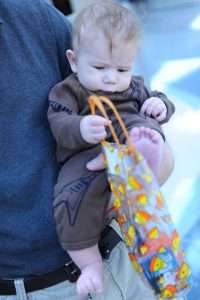
Cognitive
- Lets you know if she is happy or sad
- Responds to affection
- Reaches for toy with one hand
- Uses hands and eyes together, such as seeing a toy and reaching for it
- Follows moving things with eyes from side to side
- Watches faces closely and recognizes familiar people and things at a distance
Fine Motor
- Brings hands to mouth
- Uses hands and eyes together, such as seeing a toy and reaching for it
- Follows moving things with eyes from side to side
- Can hold a toy with whole hand (palmar grasp) and shake it and swing at dangling toys
Gross Motor
- Holds head steady, unsupported
- Pushes down on legs when feet are on a hard surface
- Maybe able to roll over from tummy to back
- Brings hands to mouth
- When lying on stomach, pushes up to elbows
Language
- Begins to babble
- Babbles with expression and copies sounds he hears
- Cries in different ways to show hunger, pain, or being tired
Social and Emotional
- Smiles spontaneously, especially at people
- Likes to play with people and might cry when playing stops
- Copies some movements and facial expressions, like smiling or frowning
Six Months
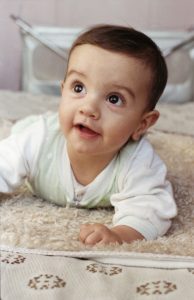
Cognitive
- Looks around at things nearby
- Brings things to mouth
- Shows curiosity about things and tries to get things that are out of reach
- Begins to pass things from one hand to the other
- Looks for partially hidden object
- Looks for fallen toys
Fine Motor
- Reaches with both arms
- Brings things to mouth
- Begins to pass things from one hand to the other
Gross Motor
- Rolls over in both directions (front to back, back to front)
- Begins to sit without support
- When standing, supports weight on legs and might bounce
- Rocks back and forth, sometimes crawling backward before moving forward
Language
- Responds to sounds by making sounds
- Strings vowels together when babbling (“ah,” “eh,” “oh”) and likes taking turns with parent while making sounds
- Responds to own name
- Makes sounds to show joy and displeasure
- Begins to say consonant sounds (jabbering with “m,” “b”)
Social and Emotional
- Knows familiar faces and begins to know if someone is a stranger
- Likes to play with others, especially parents
- Responds to other people’s emotions and often seems happy
- Likes to look at self in a mirror
Nine Months
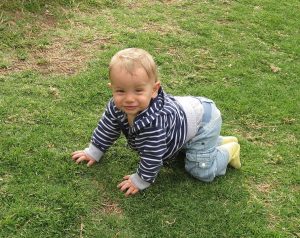
Cognitive
- Watches the path of something as it falls
- Looks for things he sees you hide
- Plays peek-a-boo
- Puts things in her mouth
- Moves things smoothly from one hand to the other
- Picks up things like cereal o’s between thumb and index finger
Fine Motor
- Puts things in her mouth
- Moves things smoothly from one hand to the other
- Picks up things between thumb and index finger (pincer grip)
Gross Motor
- Stands, holding on
- Can get into sitting position
- Sits without support
- Pulls to stand
- Crawls
Language
- Understands “no”
- Makes a lot of different sounds like “mamamama” and “bababababa”
- Copies sounds and gestures of others
- Uses fingers to point at things
Social and Emotional
- May be afraid of strangers
- May be clingy with familiar adults
- Has favorite toys
One Year
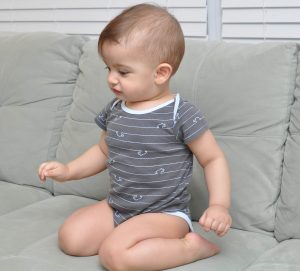
Cognitive
- Explores things in different ways, like shaking, banging, throwing
- Finds hidden things easily
- Looks at the right picture or thing when it’s named
- Imitates gestures
- Starts to use things correctly; for example, drinks from a cup, brushes hair
- Bangs two things together
Fine Motor
- Reaches with one hand
- Bangs two things together
- Puts things in a container, takes things out of a container
- Lets things go without help
- Pokes with index (pointer) finger
Gross Motor
- Gets to a sitting position without help
- Pulls up to stand, walks holding on to furniture (“cruising”)
- May take a few steps without holding on
- May stand alone
Language
- Responds to simple spoken requests
- Uses simple gestures, like shaking head “no” or waving “bye-bye”
- Makes sounds with changes in tone (sounds more like speech)
- Says “mama” and “dada” and exclamations like “uh-oh!”
- Tries to say words you say
Social and Emotional
- Is shy or nervous with strangers
- Cries when mom or dad leaves
- Has favorite things and people
- Shows fear in some situations
- Hands you a book when he wants to hear a story
- Repeats sounds or actions to get attention
- Puts out arm or leg to help with dressing
- Plays games such as “peek-a-boo” and “pat-a-cake”
18 Months
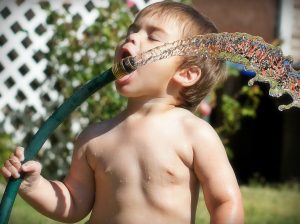
Cognitive
- Knows what ordinary things are for; for example, telephone, brush, spoon
- Points to get the attention of others
- Shows interest in a doll or stuffed animal by pretending to feed
- Points to one body part
- Scribbles on his own
- Can follow 1-step verbal commands without any gestures
Fine Motor
- Scribbles on his own
- Can help undress herself
- Drinks from a cup
- Eats with a spoon with some accuracy
- Stacks 2-4 objects
Gross Motor
- Walks alone
- Walks up stairs holding for support
- May run
- Carries and pulls toys while walking
- Can help undress herself
- Climbs onto and down from furniture
Language
- Says several words
- Say and shakes head “no”
- Points to show someone what is wanted
- Uses two word sentences
- Repeats words overheard in conversation
Social and Emotional
- Likes to hand things to others as play
- May have temper tantrums
- May be afraid of strangers
- Shows affection to familiar people
- Plays simple pretend, such as feeding a doll
- May cling to caregivers in new situations
- Points to show others something interesting
- Explores alone but with parent close by.
Two Years
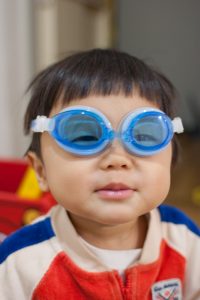
Cognitive
- Begins to sort shapes and colors
- Completes sentences and rhymes in familiar books
- Plays simple make-believe games
- Follows two-step instructions such as “Pick up your shoes and put them in the closet.”
- Names items in a picture book such as a cat, bird, or dog
- Matches object to picture in book
Fine Motor
- Builds towers of 4 or more blocks
- Might use one hand more than the other
- Makes copies of straight lines and circles
- Enjoys pouring and filling
- Unbuttons large buttons
- Unzips large zippers
- Drinks and feeds self with more accuracy
Gross Motor
- Stands on tiptoe
- Kicks a ball
- Begins to run
- Climbs onto and down from furniture without help
- Walks up and down stairs holding on
- Throws ball overhand
Language
- Points to things or pictures when they are named
- Knows names of familiar people and body parts
- Says sentences with 2 to 4 words
- Follows simple instructions
- Repeats words overheard in conversation
- Points to things in a book
Social and Emotional
- Copies others, especially adults and older children
- Gets excited when with other children
- Shows more and more independence
- Shows defiant behavior (doing what he has been told not to)
- Plays mainly beside other children, but is beginning to include other children, such as in chase games
Three Years
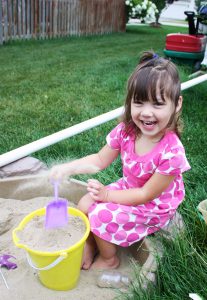
Cognitive
- Can work toys with buttons, levers, and moving parts
- Plays make-believe with dolls, animals, and people
- Does puzzles with 3 or 4 pieces
- Understands what “two” means
Fine Motor
- Copies a circle with pencil or crayon
- Turns book pages one at a time
- Builds towers or more than 6 blocks
- Screws and unscrews jar lids or turns door handle
Gross Motor
- Climbs well
- Runs easily
- Pedals a tricycle (3-wheeled bike)
- Walks up and down stairs, one foot on each step
- Kicks ball forward
- Throws ball overhand
Language
- Follows instructions with 2 or 3 steps
- Can name most familiar things
- Understands words like “in,” “on,” and “under”
- Says first name, age, and sex
- Names a friend
- Says words like “I,” “me,” “we,” and “you” and some plurals (cars, dogs, cats)
- Talks well enough for strangers to understand most of the time
- Carries on a conversation using 2 to 3 sentences
Social and Emotional
- Copies adults and friends
- Shows affection for friends without prompting
- Takes turns in games
- Shows concern for a crying friend
- Understands the idea of “mine” and “his” or “hers”
- Shows a wide range of emotions
- Separates easily from mom and dad
- May get upset with major changes in routine
- Dresses and undresses self
Four Years
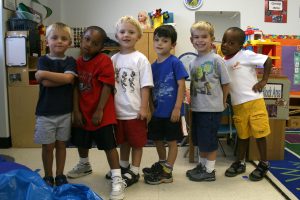
Cognitive
- Names some colors and some numbers
- Understands the idea of counting
- Starts to understand time
- Remembers parts of a story
- Understands the idea of “same” and “different”
- Plays board or card games
- Tells you what he thinks is going to happen next in a book
Fine Motor
- Pours, cuts with supervision, and mashes own food
- Uses scissors
- Starts to copy some capital letters
Gross Motor
- Hops and stands on one foot up to 2 seconds
- Catches a bounced ball most of the time
Language
- Knows some basic rules of grammar, such as correctly using “he” and “she”
- Sings a song or says a poem from memory such as the “ltsy Bitsy Spider” or the “Wheels on the Bus”
- Tells stories
- Can say first and last name
- Recalls parts of a story
Social and Emotional
- Enjoys doing new things
- Plays “Mom” and “Dad”
- Is more and more creative with make-believe play
- Would rather play with other children than by himself
- Cooperates with other children
- Often can’t tell what’s real and what’s make-believe
- Talks about what she likes and what she is interested in
Five Years
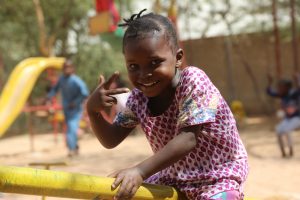
Cognitive
- Counts 10 or more things
- Knows about things used every day, like money and food
- Correctly names 4 colors
- Better understands concept of time
Fine Motor
- Can draw a person with at least 6 body parts
- Can print some letters or numbers
- Copies a triangle and geometric shapes
- Uses a fork and spoon and sometimes a table knife
Gross Motor
- Stands on one foot for 10 seconds or longer
- Hops; may be able to skip
- Can do a somersault
- Can use a toilet on her own
- Swings and climbs
Language
- Speaks very clearly
- Tells a simple story using full sentences
- Uses future tense; for example, “Grandma will be here.”
- Says name and address
- Speaks in sentences of more than 5 words
Social and Emotional
- Wants to be like and please other friends
- More likely to agree with rules
- Likes to sing, dance, and act
- Is aware of gender
- Cantell what’s real and what’s make-believe
- Shows more independence
- Is sometimes demanding and sometimes very cooperative
SIX YEARS
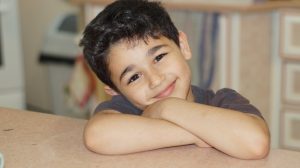
Cognitive
- Shows increased attention span
- Understands simple time markers
- Understands simple motion concepts
- Enjoys the challenges of puzzles, mazes, and games
- Names and correctly holds up right and left hand fairly consistently
- Inquisitive about surroundings and everyday events
Fine Motor
- Enjoys painting, modeling with clay, drawing, coloring
- Writes numbers and letters with varying degrees of precision and interest (might reverse or confuse certain letters: b/d, p/q, g/q, t/f)
- Traces around hand and other objects
- Folds and cuts paper into simple shapes
- Ties own shoes (some still struggle)
Gross Motor
- Movements are more precise and deliberate
- Moves constantly
- Enjoys vigorous activity
- Rides bicycle with training wheels
- Swings a bat
Language
- Talks nonstop
- Carries on adult-like conversations; asks many questions
- Uses appropriate verb tenses, word order, and sentencestructure
- Uses language to express displeasure
- Talks self through steps required in simple problem solving
- Imitates slang and profanity; finds “bathroom” talk extremely funny
- Delights in telling jokes and riddles
- Recognizes some words by sight;
- Attempts to sounds out words
Social and Emotional
- Becomes less dependent on parents
- Needs and seeks adult approval
- Anxious to please
- Sees events from almost entirely own perspective
- Easily disappointed and frustrated by self-perceived failure
- Has difficulty composing and soothing self
- Dislikes being corrected or losing at games
- Often fibs, cheats, or takes items belonging to others
- Knows when he or she has been bad based on expectations and rules
- Can be increasingly fearful
Seven Years
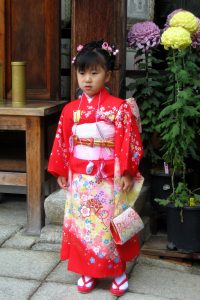
Cognitive
- Understands concepts of space and time in ways that are both logical and more practical
- Begins to grasp conservation
- Gains better understanding of cause and effect
- Tells time by clock and understands calendar time
- Plans ahead
- Shows fascination with magic tricks
- Enjoys counting and saving money
- Continues to reverse some letters and substitute sounds on occasion
Fine Motor
- Manipulates computer mouse or paintbrush with greater precision
- Uses knife and fork appropriately, but inconsistently
- Holds pencil in tight grasp near the tip; rests head on forearm, lowers head almost to the table top when doing pencil-and-paper tasks
- Produces numbers and letters in deliberate and confident fashion (more uniform)
Gross Motor
- Balances on either foot
- Runs up and down stairs with alternating feet
- Throws and catches smaller ball
- Practices a new motor skill over and over until mastered, then drops it to work on something else
- Finds floor more comfortable than furniture when reading, playing, or watching TV
- Legs are often in constant motion
Language
- Engages in storytelling
- Uses adult-like sentence structure and language in conversation
- Uses more adjectives and adverbs
- Uses gestures to illustrate conversations
- Verbal exaggeration is common
- Describes personal experiences in great detail
- Understands and carries out multiple-step directions
- Enjoys writing simple notes to friends
- Finds reading easier
- Reading skills are better than spelling skills
Social and Emotional
- Criticizes own performance
- Is cooperative and affectionate towards adults
- Is more outgoing
- Seeks outs friendships
- Can find things to do independently
- Quarrels less often
- Still tattles
- Prefers same-sex playmates; more likely to play in groups
- Blames others or makes up excuses for own behavior
- Worries about not being liked
- Feelings are easily hurt
- Can be trusted to carry out directions and commitments
- Worries about being late or not getting school work done
Eight Years

Cognitive
- Organizes and displays items according to more complex systems
- Bargains and trades collectible items
- Plan and saves money for small purchases
- Begins to take interest in what others think and do
- Understands there are distant countries and differences of opinion and culture
- Understands perspective (shadow, distance, shape)
- Grasps basic principles of conservation
- Uses more sophisticated logic in efforts to understand everyday events
- Adds and subtracts multiple digit numbers
- Learning multiplication and division
Fine Motor
- Copies words and numbers with increasing speed and accuracy
- Has good eye-hand coordination
- Drawings reflect more realistic portrayal of objects
Gross Motor
- Likes to dance, skate, swim, wrestle, ride bikes, play basketball, jump rope, and fly kites
- Seeks out opportunities to play in team activities and games
- Exhibits significant improvement in agility, balance, speed, and strength
- Possess seemingly endless energy
Language
- Reads with ease and understanding
- Writes with descriptions that are imaginative and detailed
- Uses language to criticize and compliment others
- Repeats slang and curse words
- Understands and follows rules of grammar in conversation and written form
- Is intrigued with learning secret word codes or using code language
- Able to think and talk about past and future
Social and Emotional
- Begins to form opinions about moral values and attitudes
- Plays with two or three best friends; most often of same age and gender
- Enjoys spending some time alone
- Participates in team games and activities
- Acceptance by peers is important
- Enjoys talking on the phone with friends and family
- Seems less critical of own performance, but is easily
- Understands others may have more talent in a specific area
- Enjoys performing for adults and challenging them in games
9 & 10 Years
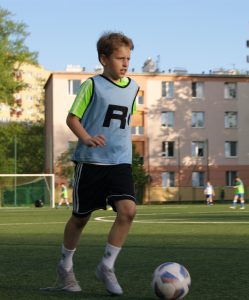
Cognitive
- Develops ability to reason based more on experience and logic more than intuition
- Likes challenges in arithmetic but does not always understand complex mathematical concepts
- Learns best through hands-on learning (researching, experimenting, building models, dramatizing)
- Finds it difficult to sit still for periods longer than 30 minutes;
- Uses reading and writing skills for nonacademic activities
- Shows improved understanding of cause and effect
- Continues to master concepts of time, weight, volume, and distance
- Able to think in reverse, following a series of occurrences back to their beginnings
- Prefers reading books that are longer and descriptive, with complex plots
Fine Motor
- Writes, sketches, and performs fine motor skills with improved coordination
- Likes to use hands for arts and crafts, cooking, woodworking, needlework, painting, building models, and taking apart objects such as a clock or telephone
- Draws pictures in details
- Takes great joy in perfecting handwriting skills
Gross Motor
- Throws a ball with accuracy
- Uses arms, legs, and feet with ease and improved precision
- Runs, climbs, skips ropes, swims, rides bikes, and skates with skill and confidence
- Enjoys team sports, but may still need to develop some of the necessary complex skills
Language
- Talks, often nonstop and for no specific reason; sometimes just for attention
- Expresses feelings in effectively through words
- Understands and uses language as a system for communicating with others
- Uses slang expressions commonly expressed by peers
- Recognizes that some words have double meaning
- Finds humor in using illogical metaphors in jokes and riddles
- Shows advanced understanding of grammatical sequences
- Recognizes when a sentence is not grammatically correct
Social and Emotional
- Becomes less dependent on parents
- Needs and seeks adult approval
- Anxious to please
- Sees events from almost entirely own perspective
- Easily disappointed and frustrated by self-perceived failure
- Has difficulty composing and soothing self
- Dislikes being corrected or losing at games
- Often fibs, cheats, or takes items belonging to others
- Knows when he or she has been bad based on expectations and rules
- Can be increasingly fearful
11 &12 Years

Cognitive
- Begins thinking in more abstract terms
- No longer needs to rely on experiencing an event to understand it
- Accepts the idea that problems can have multiple solutions
- Completes the majority of language develop by the end of this stage
- Often works through problems by talking aloud to self
- Develops solutions or responses based on logic
- Enjoys challenges, problem-solving, researching, and testing possible solutions
- Stays focused on completing tasks
- Develops detailed plans and lists to reach a desired goal
- Performs many routine tasks without having to think
- Learns from errors using cause-and-effect
Fine Motor
- Concentrates efforts on continued refinement of fine motor ability
- Likes to sew and paint
Gross Motor
- Displays movements that are smoother and more coordinated
- Rapid growth can cause temporary clumsiness
- Enjoys participation in activities and organized games in which improved skills can be used and tested
- Requires outlets for release of excess energy that builds during the school day
- Enjoys team sports, riding bikes, playing in the park, taking dance lessons, going for a walk with friends, shooting hoops, playing soccer
- Has an abundance of energy but also fatigues quickly
- Uses improved strength to run faster, throw balls farther, jump higher, kick or bat balls more accurately, and wrestle friends
Language
- Completes the majority of language develop by the end of this stage
- Often works through problems by talking aloud to self
- Talk and argues, often nonstop, with anyone who will listen
- Uses longer and more complex sentence structures
- Masters increasingly complex vocabulary
- Adds 4,000-5,000 new words each year
- Weaves elaborate stories with precise descriptions
- Becomes a thoughtful listener
- Understands that word statements can have implied meanings
- Grasps concepts of irony and sarcasm
- Enjoys telling jokes, riddles, and rhymes to entertain others
- Masters several language styles, shifting back and forth based on the occasion
Social and Emotional
- Organizes group games but may modify rules while the game is in progress
- View self-image as very important
- Defines self in terms of appearance, possessions, and activities
- Becomes increasingly self-conscious and self-focused
- Understands the need to assume responsibility for his or her own behavior
- Daydreams and fantasizes about the future (including career)
- Develops a critical and idealistic view of the world
- Expresses interests in other cultures, foods, languages, and customs
- Adopts dress, hairstyles, and mannerisms of celebrities
- May spend more time now with peers than with family members
- is able to discuss what is emotionally troubling
Attribution
This chapter is copied from Appendix C – Developmental Milestones is shared under a CC BY license and was authored, remixed, and/or curated by Jennifer Paris, Kristin Beeve, & Clint Springer.

